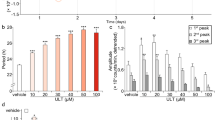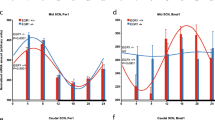Abstract
Circadian rhythms are generated through a transcription-translation feedback loop involving clock genes and the casein kinases CSNK1D and CSNK1E. In this study, we investigated the effects of the casein kinase inhibitor PF-670462 (50 mg/kg) on rhythmic expression of clock genes in the liver, pancreas and suprachiasmatic nucleus (SCN) as well as plasma corticosterone, melatonin and running behaviour in rats and compared them to the responses to a 4 h extension of the light phase. PF-670462 acutely phase delayed the rhythmic transcription of Bmal1, Per1, Per2 and Nr1d1 in both liver and pancreas by 4.5 ± 1.3 and 4.5 ± 1.2 h, respectively, 1 day after administration. In the SCN, the rhythm of Nr1d1 and Dbp mRNA expression was delayed by 4.2 and 4 h, respectively. Despite these changes, the time of peak plasma melatonin secretion was not delayed, although the plasma corticosterone rhythm and onset of wheel-running activity were delayed by 2.1 and 1.1 h, respectively. These changes are in contrast to the effects of the 4 h light extension, which resulted in delays in peak expression of the clock genes of less than 1 h and no change in the melatonin or corticosterone rhythms. The ability of the casein kinase inhibitor to bring about large phase shifts in the rhythms of major metabolic target tissues may lead to new drugs being developed to rapidly phase adjust circadian rhythms to alleviate the metabolic impact of shift work.







Similar content being viewed by others
Abbreviations
- Actb :
-
Beta actin
- Bmal1 :
-
Brain and muscle ARNT-like protein 1, Arntl and Mop3
- Nr1d1 :
-
Nuclear receptor subfamily 1, group D, member 1, also known as Rev erb alpha
- Per1 :
-
Period 1
- Per2 :
-
Period 2
- Cry1 :
-
Cryptochrome 1
- Cry2 :
-
Cryptochrome 2
- Dbp :
-
D site of albumin promoter (albumin D-box) binding protein
References
Albrecht U (2012) Timing to perfection: the biology of central and peripheral circadian clocks. Neuron 74:246–260
Cailotto C, Lei J, van der Vliet J, van Heijningen C, van Eden CG, Kalsbeek A, Pevet P, Buijs RM (2009) Effects of nocturnal light on (clock) gene expression in peripheral organs: a role for the autonomic innervation of the liver. PLoS ONE 4:e5650
Teclemariam Mesbah R, Ter Horst GJ, Postema F, Wortel J, Buijs RM (1999) Anatomical demonstration of the suprachiasmatic nucleus-pineal pathway. J Comp Neurol 406:171–182
St Hilaire MA, Gooley JJ, Khalsa SBS, Kronauer RE, Czeisler CA, Lockley SW (2012) Human phase response curve to a 1 h pulse of bright white light. J Physiol 590:3035–3045
Spoelstra K, Albrecht U, van der Horst GT, Brauer V, Daan S (2004) Phase responses to light pulses in mice lacking functional per or cry genes. J Biol Rhythms 19:518–529
Summer TL, Ferraro JS, McCormack CE (1984) Phase-response and Aschoff illuminance curves for locomotor activity rhythm of the rat. Am J Physiol Regul Integr Comp Physiol 246:R299–R304
Stepien JM, Kennaway DJ (2001) Phase response relationships between light pulses and the melatonin rhythm in rats. J Biol Rhythms 16:234–242
Kohler M, Kalkowski A, Wollnik F (1999) Serotonin agonist quipazine induces photic-like phase shifts of the circadian activity rhythm and c-fos expression in the rat suprachiasmatic nucleus. J Biol Rhythms 14:131–140
Kennaway DJ, Moyer RW (1998) Serotonin 5-HT 2C agonists mimic the effect of light pulses on circadian rhythms. Brain Res 806:257–270
Kennaway DJ, Rowe SA (2000) Effect of stimulation of endogenous melatonin secretion during constant light exposure on 6-sulphatoxymelatonin rhythmicity in rats. J Pineal Res 28:16–25
Comas M, Beersma DGM, Spoelstra K, Daan S (2006) Phase and period responses of the circadian system of mice (Mus musculus) to light stimuli of different duration. J Biol Rhythms 21:362–372
Davidson AJ, Yamazaki S, Arble DM, Menaker M, Block GD (2008) Resetting of central and peripheral circadian oscillators in aged rats. Neurobiol Aging 29:471–477
Mohawk JA, Green CB, Takahashi JS (2012) Central and peripheral circadian clocks in mammals. Annu Rev Neurosci 35:445–462
Lee C, Etchegaray JP, Cagampang FRA, Loudon ASI, Reppert SM (2001) Posttranslational mechanisms regulate the mammalian circadian clock. Cell 107:855–867
Akashi M, Tsuchiya Y, Yoshino T, Nishida E (2002) Control of intracellular dynamics of mammalian period proteins by casein kinase I epsilon (CKIepsilon) and CKIdelta in cultured cells. Mol Cell Biol 22:1693–1703
Meng Q-J, Maywood ES, Bechtold DA, Lu W-Q, Li J, Gibbs JE, Dupré SM, Chesham JE, Rajamohan F, Knafels J, Sneed B, Zawadzke LE, Ohren JF, Walton KM, Wager TT, Hastings MH, Loudon ASI (2010) Entrainment of disrupted circadian behavior through inhibition of casein kinase 1 (CK1) enzymes. Proc Natl Acad Sci USA 107:15240–15245
van Ooijen G, Hindle M, Martin SF, Barrios-Llerena M, Sanchez F, Bouget F-Y, O’Neill JS, Le Bihan T, Millar AJ (2013) Functional analysis of Casein Kinase 1 in a minimal circadian system. PLoS ONE 8:e70021
Querfurth C, Diernfellner ACR, Gin E, Malzahn E, Höfer T, Brunner M (2011) Circadian conformational change of the Neurospora clock protein FREQUENCY triggered by clustered hyperphosphorylation of a basic domain. Mol Cell 43:713–722
Zhang L, Hastings MH, Green EW, Tauber E, Sladek M, Webster SG, Kyriacou CP, Wilcockson DC (2013) Dissociation of circadian and circatidal timekeeping in the marine crustacean Eurydice pulchra. Curr Biol 23:1863–1873
Smadja Storz S, Tovin A, Mracek P, Alon S, Foulkes NS, Gothilf Y (2013) Casein kinase 1δ activity: a key element in the zebrafish circadian timing system. PLoS ONE 8:e54189
Badura L, Swanson T, Adamowicz W, Adams J, Cianfrogna J, Fisher K, Holland J, Kleiman R, Nelson F, Reynolds L, St GK, Schaeffer E, Tate B, Sprouse J (2007) An inhibitor of casein kinase I epsilon induces phase delays in circadian rhythms under free-running and entrained conditions. J Pharmacol Exp Ther 322:730–738
Sprouse J, Reynolds L, Kleiman R, Tate B, Swanson T, Pickard G (2010) Chronic treatment with a selective inhibitor of casein kinase I δ/ε yields cumulative phase delays in circadian rhythms. Psychopharmacology 210:569–576
Walton KM, Fisher K, Rubitski D, Marconi M, Meng Q-J, Sladek M, Adams J, Bass M, Chandrasekaran R, Butler T, Griffor M, Rajamohan F, Serpa M, Chen Y, Claffey M, Hastings M, Loudon A, Maywood E, Ohren J, Doran A, Wager TT (2009) Selective inhibition of casein kinase 1 epsilon minimally alters circadian clock period. J Pharmacol Exp Ther 330:430–439
Kim JK, Forger DB, Marconi M, Wood D, Doran A, Wager T, Chang C, Walton KM (2013) Modeling and validating chronic pharmacological manipulation of circadian rhythms. CPT Pharmacometrics Syst Pharmacol 2:e57
Sprouse J, Reynolds L, Swanson T, Engwall M (2009) Inhibition of casein kinase I ε/δ produces phase shifts in the circadian rhythms of Cynomolgus monkeys. Psychopharmacology 204:735–742
Marcheva B, Ramsey KM, Buhr ED, Kobayashi Y, Su H, Ko CH, Ivanova G, Omura C, Mo S, Vitaterna MH, Lopez JP, Philipson LH, Bradfield CA, Crosby SD, JeBailey L, Wang X, Takahashi JS, Bass J (2010) Disruption of the clock components CLOCK and BMAL1 leads to hypoinsulinaemia and diabetes. Nature 466:627–631
Lamia KA, Storch KF, Weitz CJ (2008) Physiological significance of a peripheral tissue circadian clock. Proc Natl Acad Sci USA 105:15172–15177
Sadacca LA, Lamia KA, deLemos AS, Blum B, Weitz CJ (2011) An intrinsic circadian clock of the pancreas is required for normal insulin release and glucose homeostasis in mice. Diabetologia 54:120–124
Illnerova H, Vanecek J (1987) Entrainment of the circadian rhythm in the rat pineal N-acetyltransferase activity by prolonged periods of light. J Comp Physiol A 161:495–510
Varcoe TJ, Kennaway DJ, Voultsios A (2003) Activation of 5-HT(2C) receptors acutely induces Per gene expression in the rat suprachiasmatic nucleus at night. Brain Res Mol Brain Res 119:192–200
Voultsios A, Kennaway DJ, Dawson D (1997) Salivary melatonin as a circadian phase marker: Validation and comparison with plasma melatonin. J Biol Rhythms 12:457–466
Oster H, Damerow S, Hut RA, Eichele G (2006) Transcriptional profiling in the adrenal gland reveals circadian regulation of hormone biosynthesis genes and nucleosome assembly genes. J Biol Rhythms 21:350–361
Yan L (2009) Expression of clock genes in the suprachiasmatic nucleus: effect of environmental lighting conditions. Rev Endocr Metab Disord 10:301–310
Reddy AB, Field MD, Maywood ES, Hastings MH (2002) Differential resynchronisation of circadian clock gene expression within the suprachiasmatic nuclei of mice subjected to experimental jet lag. J Neurosci 22:7326–7330
Vyas MV, Garg AX, Iansavichus AV, Costella J, Donner A, Laugsand LE, Janszky I, Mrkobrada M, Parraga G, Hackam DG (2012) Shift work and vascular events: systematic review and meta-analysis. BMJ 345:e4800
Gan Y, Yang C, Tong X, Sun H, Cong Y, Yin X, Li L, Cao S, Dong X, Gong Y, Shi O, Deng J, Bi H, Lu Z (2014) Shift work and diabetes mellitus: a meta-analysis of observational studies. Occup Environ Med. doi:10.1136/oemed-2014-102150
Acknowledgments
This work was supported by a grant (GNT1029869) from the National Health and Medical Research Council (NHMRC) of Australia to DJK. DJK is an NHMRC Senior Research Fellow. We thank Dr Jeffrey Sprouse and Lundbeck Research USA for the generous gift of PF-670462.
Conflict of interest
The authors have no conflicts of interest.
Author information
Authors and Affiliations
Corresponding author
Rights and permissions
About this article
Cite this article
Kennaway, D.J., Varcoe, T.J., Voultsios, A. et al. Acute inhibition of casein kinase 1δ/ε rapidly delays peripheral clock gene rhythms. Mol Cell Biochem 398, 195–206 (2015). https://doi.org/10.1007/s11010-014-2219-8
Received:
Accepted:
Published:
Issue Date:
DOI: https://doi.org/10.1007/s11010-014-2219-8




